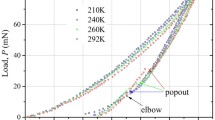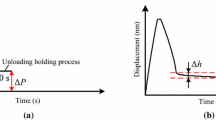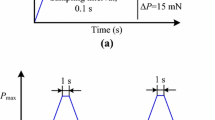Abstract
Silicon in its diamond-cubic phase is known to phase transform to a technologically interesting mixture of the body-centred cubic and rhombohedral phases under nanoindentation pressure. In this study, we demonstrate that during plastic deformation the sample can traverse two distinct pathways, one that initially nucleates a phase transformation while the other initially nucleates crystalline defects. These two pathways remain distinct even after sufficient pressure is applied such that both deformation mechanisms are present within the sample. It is further shown that the indents that initially nucleate a phase transformation generate larger, more uniform volumes of the phase transformed material than indents that initially nucleate crystalline defects.








Similar content being viewed by others
References
Morin FJ, Maita JP (1954) Electrical properties of silicon containing arsenic and boron. Phys Rev 96(1):28–35
Nicollia Eh, Goetzber A (1967) Si-Sio2 interface - electrical properties as determined by metal-insulator-silicon conductance technique. Bell Syst Tech J 46(6): p. 1055 − +
Williams JS et al (1999) Ultra-micro-indentation of silicon and compound semiconductors with spherical indenters. J Mater Res 14(6):2338–2343
Williams JS, Field JS, Swain MV (1993) Mechanical property characterisation of crystalline, ion implantation amorphised and annealed relaxed silicon with spherical indenters. MRS Proceedings. vol 308. Cambridge University Press
Beekman M (2015) New hopes for allotropes. Mater Today 18(6):304–305
Mujica A, Pickard CJ, Needs RJ (2015) Low-energy tetrahedral polymorphs of carbon, silicon, and germanium. Phys Rev B 91(21)
Wang QQ et al (2014) Direct band gap silicon allotropes. J Am Chem Soc 136(28):9826–9829
Wippermann S et al (2013) High-pressure core structures of si nanoparticles for solar energy conversion. Phys Rev Lett 110(4)
Minomura S, Drickamer HG (1962) Pressure induced phase transitions in silicon, germanium and some 3–5 compounds. J Phys Chem Solids 23: 451-&
Crain J et al (1994) Reversible pressure-induced structural transitions between metastable phases of silicon. Phys Rev B 50(17):13043–13046
Piltz RO et al (1995) Structure and properties of silicon-Xii - a complex tetrahedrally bonded phase. Phys Rev B 52(6):4072–4085
Kasper JS, Wentorf RH (1977) Hexagonal (Wurtzite) silicon. Science 197(4303):599–599
Wentorf RH, Kasper JS (1963) New forms of silicon. Science 139(355): 338-&
Pharr GM, Oliver WC, Harding DS (1991) New evidence for a pressure-induced phase-transformation during the indentation of silicon. J Mater Res 6(6):1129–1130
Gupta MC, Ruoff AL (1980) Static compression of silicon in the [100] and in the [111] directions. J Appl Phys 51(2):1072–1075
Han CF, Lin JF (2010) The model developed for stress-induced structural phase transformations of micro-crystalline silicon films. Nano Micro Lett 2(2):68–73
Kailer A, Gogotsi YG, Nickel KG (1997) Phase transformations of silicon caused by contact loading. J Appl Phys 81(7):3057–3063
Gerbig YB et al (2012) In situ observation of the indentation-induced phase transformation of silicon thin films. Phys Rev B 85(10)
Malone BD, Sau JD, Cohen ML (2008) Ab initio study of the optical properties of Si-XII. Phys Rev B 78(16)
Ruffell S et al (2011) Experimental evidence for semiconducting behavior of Si-XII. Phys Rev B 83(7).
Ruffell, S., et al., Room temperature writing of electrically conductive and insulating zones in silicon by nanoindentation. Applied Physics Letters, 2011. 98(5).
Malone BD, Sau JD, Cohen ML (2008) Ab initio survey of the electronic structure of tetrahedrally bonded phases of silicon. Phys Rev B 78(3)
Besson JM et al (1987) Electrical-properties of semimetallic silicon-iii and semiconductive silicon-iv at ambient pressure. Phys Rev Lett 59(4):473–476
Rao R, Bradby JE, Williams JS (2007) Patterning of silicon by indentation and chemical etching. Appl Phys Lett 91(12)
Wong S et al (2015) Phase transformation as the single-mode mechanical deformation of silicon. Appl Phys Lett 106(25)
Dubois SMM et al (2006) Ideal strength of silicon: An ab initio study. Phys Rev B 74(23)
Haberl B et al (2006) Phase transformations induced by spherical indentation in ion-implanted amorphous silicon. J Appl Phys 100(1)
Ruffell S et al (2009) Annealing of nanoindentation-induced high pressure crystalline phases created in crystalline and amorphous silicon. J Appl Phys 105(9)
Bradby JE et al (2001) Mechanical deformation in silicon by micro-indentation. J Mater Res 16(5):1500–1507
Wermelinger T, Spolenak R (2009) Correlating Raman peak shifts with phase transformation and defect densities: a comprehensive TEM and Raman study on silicon. J Raman Spectrosc 40(6):679–686
Saka H et al (2002) Transmission electron microscopy of amorphization and phase transformation beneath indents in Si. Philos Mag A 82(10):1971–1981
Wong S et al (2015) The influence of hold time on the onset of plastic deformation in silicon. J Appl Phys 118(24)
Radeberg A (2006) Finite element software package Elastica 3.0
Johnson BC et al (2011) Temperature dependence of Raman scattering from the high-pressure phases of Si induced by indentation. Phys Rev B 83(23)
Chrobak D et al (2013) Nanoindentation experiments with different loading rate distinguish the mechanism of incipient plasticity. Appl Phys Lett 103(7)
Hu JZ et al (1986) Crystal data for high-pressure phases of silicon. Phys Rev B 34(7):4679–4684
Suzuki T, Ohmura T (1996) Ultra-microindentation of silicon at elevated temperatures. Philos Mag A 74(5):1073–1084
Kiran MSRN et al (2015) Temperature-dependent mechanical deformation of silicon at the nanoscale: Phase transformation versus defect propagation. J Appl Phys 117(20)
Du XC et al (2015) Molecular dynamics investigations of mechanical behaviours in monocrystalline silicon due to nanoindentation at cryogenic temperatures and room temperature. Sci Reports 5
Acknowledgments
This work was performed in part at the ACT node of the Australian National Fabrication Facility, a company established under the National Collaborative Research Infrastructure Strategy to provide nano and micro-fabrication facilities for Australian researchers. We also thank the ACT node of the Australian Microscopy and Microanalysis Research Facility for use of the TEM facilities. Funding from the Australian Research Council is gratefully acknowledged. Assoc. Prof Bradby would like to acknowledge the Australian Research Council for a Future Fellowship. Dr. Haberl gratefully acknowledges current funding from an Alvin M. Weinberg Fellowship (ORNL) and the Spallation Neutron Source (ORNL), sponsored by the U.S. Department of Energy, Office of Basic Energy Sciences. ORNL is funded under DOE-BES contract number, DE-AC05-00OR22725, the SNS is supported by the Scientific User Facilities division, DOE-BES under Contract No.DE-AC05-00OR22725 and the Alvin M. Weinberg Fellowship by the ORNL LDRD scheme under Project No. 7620.
Author information
Authors and Affiliations
Corresponding author
Rights and permissions
About this article
Cite this article
Wong, S., Haberl, B., Williams, J.S. et al. Phase Transformation Dependence on Initial Plastic Deformation Mode in Si via Nanoindentation. Exp Mech 57, 1037–1043 (2017). https://doi.org/10.1007/s11340-016-0213-7
Received:
Accepted:
Published:
Issue Date:
DOI: https://doi.org/10.1007/s11340-016-0213-7




